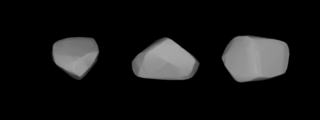
Achilles is a large Jupiter trojan asteroid of the Greek camp. Achilles was the first Jupiter trojan to be discovered, and was discovered by Max Wolf at the Heidelberg Observatory in 1906. Wolf named the minor planet after the legendary hero Achilles from Greek mythology. The dark D-type asteroid measures approximately 133 kilometers in diameter which makes it one of the 10 largest Jupiter trojans. It has a rotation period of 7.3 hours and possibly a spherical shape.

Lydia is a large belt asteroid with an M-type spectrum, and thus may be metallic in composition, consisting primarily of nickel-iron. It was discovered by French astronomer Alphonse Borrelly on 19 April 1870 and was named for Lydia, the Asia Minor country populated by Phrygians. The Lydia family of asteroids is named after it.
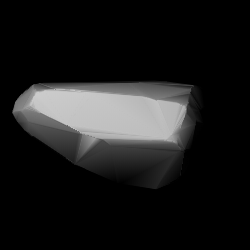
Austria is a main-belt asteroid that was found by the prolific asteroid discoverer Johann Palisa on 18 March 1874, from the Austrian Naval Observatory in Pola, Istria. It was his first asteroid discovery and was given the Latin name of his homeland.

Tolosa is a brightly coloured, stony background asteroid from the inner region of the asteroid belt. It was discovered by French astronomer Henri Joseph Perrotin on 19 May 1874, and named by the Latin and Occitan name of the French city of Toulouse.

168 Sibylla is a large main-belt asteroid, discovered by Canadian-American astronomer J. C. Watson on September 28, 1876. It was most likely named for the Sibyls, referring to the Ancient Greek female oracles. Based upon its spectrum this object is classified as a C-type asteroid, which indicates it is very dark and composed of primitive carbonaceous materials. 168 Sibylla is a Cybele asteroid, orbiting beyond most of the main-belt asteroids.

Eucharis is a large, slowly rotating main-belt asteroid that was discovered by French astronomer Pablo Cottenot on February 2, 1878, from Marseille Observatory. It was his only asteroid discovery. This object was named after Eucharis, a nymph from the 17th-century novel Les Aventures de Télémaque.
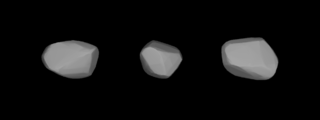
Amherstia was the 8th asteroid discovered by Raymond Smith Dugan, and was named after Amherst College, his alma mater. Amherstia is a large M-type main belt asteroid, with an estimated diameter of 73 km. It follows an eccentric orbit between Jupiter and Mars, with an orbital period of 4.39 years. The orbital plane is inclined at an angle of 13° to the ecliptic.

3554 Amun is an Aten asteroid, meaning it crosses Earth's orbit, and a Venus-crosser. It was discovered on 4 March 1986 by Carolyn and Eugene Shoemaker at Mount Palomar Observatory, and named for the ancient Egyptian deity Amun. Amun was the fifth Aten asteroid to be numbered.

Penelope is a large main belt asteroid that was discovered by Austrian astronomer Johann Palisa on August 7, 1879, in Pola. The asteroid is named after Penelope, the wife of Odysseus in Homer's The Odyssey. It is orbiting the Sun at a distance of 2.68 AU with an eccentricity (ovalness) of 0.18 and a period of 4.381 years. The orbital plane is tilted at an angle of 5.8° to the plane of the ecliptic.
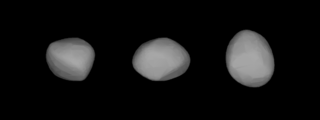
Unitas is a typical main belt asteroid that was discovered by Elia Millosevich on 1 March 1891 in Rome. The asteroid was named by the director of the Modena Observatory in honor of the Italian astronomer Angelo Secchi and the unification of Italy. It is classified as an S-type asteroid.
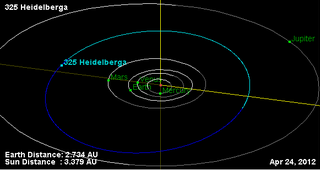
Heidelberga is a large main belt asteroid that was discovered by German astronomer Max Wolf on 4 March 1892 in Heidelberg. It is orbiting the Sun at a distance of 3.21 AU with an eccentricity of 0.159. The orbital plane is inclined at an angle of 8.55° to the ecliptic.

Vienna is a typical Main belt asteroid. It was discovered by French astronomer Auguste Charlois on 19 December 1894 in Nice, and was most likely named after the city of Vienna, Austria. This object is orbiting the Sun at a distance of 2.64 AU with an orbital eccentricity (ovalness) of 0.246 and a period of 4.28 yr. The orbital plane is inclined at an angle of 12.85° to the ecliptic.

Edburga is a typical Main belt asteroid. Max Wolf discovered it on 7 January 1896 at Heidelberg Observatory. The origin of the name is unknown. This asteroid is orbiting the Sun at a distance of 2.58 AU with a period of 4.15 yr and an eccentricity of 0.34. Its orbital plane is inclined at an angle of 18.7° to the plane of the ecliptic.
Hansa, provisional designation 1901 GL, is a stony asteroid and the namesake of the Hansa family located in the central region of the asteroid belt, approximately 56 kilometers in diameter. It was discovered on 21 May 1901, by astronomers Max Wolf and Luigi Carnera at the Heidelberg Observatory in southwest Germany. The S-type asteroid has a rotation period of 16.19 hours and possibly an elongated shape. It was named after the Hanseatic League, a medieval European trade association.
Cora, provisional designation 1902 LK, is a metallic asteroid from the middle region of the asteroid belt, approximately 30 kilometers in diameter. It was discovered by American astronomer Solon Bailey at Harvard's Boyden Station in Arequipa, Peru, on 30 June 1902. It was later named after Cora, a figure in Inca mythology.
742 Edisona is a minor planet, specifically an asteroid orbiting in the asteroid belt that was discovered by German astronomer Franz Kaiser on February 23, 1913. It was named for inventor Thomas Edison. This asteroid is orbiting 3.01 AU with a period of 5.22 years and an eccentricity of 0.119. The orbital plane is inclined at an angle of 11.2° to the plane of the ecliptic. This is a member of the dynamic Eos family of asteroids that most likely formed as the result of a collisional breakup of a parent body.
774 Armor is a minor planet orbiting in the main belt. It was discovered on December 13, 1913, in Paris by French astronomer Charles le Morvan and was named after the Celtic region of Armorica. The asteroid is orbiting at a distance of 3.05 AU with a period of 5.32 yr and an eccentricity of 0.169. The orbital plane is inclined by an angle of 5.56° to the plane of the ecliptic.
925 Alphonsina, provisional designation 1920 GM, is a stony Hansian asteroid from the central region of the asteroid belt, approximately 58 kilometers in diameter. It was discovered on 13 January 1920, by Catalan astronomer Josep Comas i Solà at the Fabra Observatory in Barcelona, Spain. The S-type asteroid has a rotation period of 7.88 hours. It was named for the Spanish Kings Alfonso X and Alfonso XIII.
1123 Shapleya, provisional designation 1928 ST, is a stony Florian asteroid from the inner regions of the asteroid belt, approximately 11 kilometers in diameter. It was discovered on 21 September 1928, by Russian astronomer Grigory Neujmin at Simeiz Observatory on the Crimean peninsula. It was named after American astronomer Harlow Shapley.
3066 McFadden, provisional designation 1984 EO, is a stony background asteroid from the central regions of the asteroid belt, approximately 15 kilometers in diameter. It was discovered on 1 March 1984, by American astronomer Edward Bowell at the Anderson Mesa Station near Tucson, Arizona. It was named for American planetary scientist Lucy-Ann McFadden. The assumed S-type asteroid has a rotation period of 13.8 hours.












